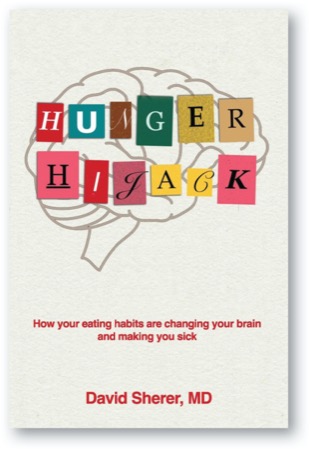The following is presented as part of our occasional series in which we excerpt books written by anesthesiologists. We ask: Do you have a book in you, too?
So far I have attempted to give you an elementary but broad view of what bad food does to you and how the spread of UPF (ultra processed food) around the world has affected global health and well-being. Being but part of the story, bad diets combined with bad habits – like physical inactivity, substance abuse, and unregulated mental stress – augment each other in synergistic assaults on human physiology. Ever since a flurry of scholarly articles, mainstream media coverage, and books on the danger of processed food (by authors such as David Kessler and Michael Moss) appeared a little more than a decade ago more attention has been paid to the matter but to apparently little avail. Rates of overweight/obesity continue their unhindered rise and the UPF makers reap ever-growing profits.
Despite the drumbeat of warnings emanating from medical centers, medical schools, universities, government agencies and world health bodies, and think tanks all over the globe about the rising rates of obesity, cancer and cardiovascular disease in younger people, the costs in both human suffering and monetary capital and the generally bleak prospects for a quick solution remain.
We in the medical community shake our heads as to the best course of action. After all, voices much more famous and influential than mine – think former FDA Commissioner David A. Kessler, University College London professor Chris Van Tulleken, and award-winning journalist Michael Moss – have all written excellent and in-depth books about the topic without inducing the necessary change to positively effect worldwide health. Many people who follow this topic offer reasons why this is the case and I will now add my opinions to the chorus of those expressing their frustration and throwing their hands up in despair.
Many of these ideas are not original by any means but they merit repeating – and tweaking. Many of you reading this may find that in my deviation from hard science in this section this discussion is based merely on opinion. But do realize I base these opinions – as a physician with 40 years in medicine – on a careful study of the literature, an understanding of the anatomy, physiology, and pathophysiology (biology of disease states) of the impact of higher body mass indexes, and as a careful student of patient – and therefore human – behavior.
The first and foremost of the challenges we face is a socio- logical one; the one I consider the most daunting to overcome. That is the issue of cultural enmeshment. By that I do not mean the more traditional use of the term, which can refer to “culture” as having to do with related ethnic or even racial groups. I mean something more subtle and insidious, more akin to sociological ingraining and an inability to look beyond oneself and see what the real truth is behind a given constellation of cultural norms.
One of my favorite phrases in the world of philosophy comes from Arthur Schopenhauer, who famously said “Talent hits a target no one else can hit; genius hits a target no one else can see.” And when it comes to “groupthink”, whereby a group of individuals of any size accepts given norms and realities without the use of critical thought or the ability to consider alternatives, this becomes particularly perilous when addiction is added to the mixture. Since I contend that much of the weight and resultant health problems the world faces today is based on addiction, the additional parameters of groupthink mentality and cultural inability to “hit a target no one else can see”, that is, to see the real impact of what your individual behavior is doing to your health due to prevailing attitudes and sentiment, is seemingly impossible to achieve.
I will give you an example. I grew up in, and live now in, one of the most affluent and well-educated counties in the United States – Montgomery County, Maryland. (My hometown of Bethesda is not only known as the home of the world-famous National Institutes of Health, Howard Hughes Medical Center, and Naval Support Activity Bethesda: Walter Reed, but also distinctive for the following demographics, as of 2017: according to the Bethesda Urban Partnership Bethesda’s median household income is $154,559, of those 25 years of age and older the education attainment level of at least a Bachelor’s degree is 83.7 percent, and the owner occupied housing unit rate is 67.3 percent.) More broadly, according to DATAUSA the 2021 median household income in Montgomery County itself was $117,345, and the median property value was $508,600. The 2022 United States Census reported that 60 percent of Montgomery County residents 25 years of age and older have at least a bachelor’s degree.
Despite this impressive array of statistics, when I talk to people in my community about the dangers of UPF to their health, they look at me as if I was speaking in tongues. I know that is a mere anecdotal allusion but these are not: According to a 2016 Montgomery County Maryland Government report entitled “Healthy Montgomery Core Measures”, 58.7 percent of county residents were either overweight or obese.
From 2018-2019, 22.4 percent of high school students were obese in Montgomery County and 56.4 percent of adults were either overweight or obese in Montgomery County in 2019, according to the report “2022 Montgomery County Hospital Collaborative Community Health Needs Assessment” on adventisthealthcare.com.
Although these metrics are lower than the national average, the idea that in a county as affluent, educated, and well-informed as Montgomery County, Maryland almost 6 out of 10 adult res- idents are either overweight or obese boggles my mind. To me this underlies a clear truth, and that is despite relative affluence and higher education, adults in Montgomery County, Maryland, and apparently elsewhere all over the world, are consistently and continually engaging in dietary and other behaviors that – because of higher BMIs – jeopardize their health.
There are, I feel, multiple factors at play. The reasons for failure in making a dent in the issue are many and, in my view, fall into these categories: the tight grip of addiction, the immense power of the UPF makers and big pharma, the “normalization” of obesity, the cost of healthy food and the presence of “food deserts”, the issue of convenience and food preparation time constraints with regard to working people, health illiteracy, and patient mentality regarding medication versus lifestyle changes.

Sherer is a retired anesthesiologist. You can find the book here on Amazon.



Please log in to post a comment
Interesting data and presentation from this excerpt from your book which i didn’t read; yet. So- the theory that obesity and poor health habits are a minority problem/ indigent population is now becoming a myth?
Have you any solutions that would be feasible ?
I have a solution, and it’s the likely the only one that will work. I have read widely on this topic. I have also experienced severe insomnia and mental health problems, due to poor diet compounding stress, It took a crisis for me to get me off UPFs, mostly. Processed foods are simply addictive, no other way to say it! You have to treat these poisons like alcohol and tobacco, and develop a system to tax them heavily. Given government’s propensity for waste and abuse, you need laws stating that the revenue can only go to subsidizing healthy foods and paying.medical expenses. I’ve debated this with libertarians, and I simply ask them how long they’ve supported Socialism. The majority of medical expenses are shared by taxpayers and higher income earners. Passing on to society the high cost of medical treatment for UPF consumers, is a form of Socialism.